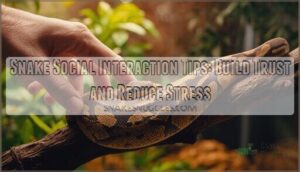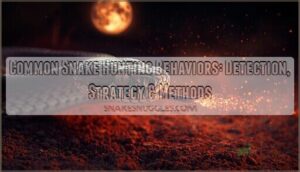This site is supported by our readers. We may earn a commission, at no cost to you, if you purchase through links.
Your ball python has been coiled tightly in the corner of its enclosure for three days, refusing food and tensing up whenever you approach. Many snake owners misinterpret this as their pet’s natural temperament, when it’s actually a clear signal of stress that regular, positive social interaction could help resolve.
Snakes may be solitary in the wild, but in captivity they benefit greatly from thoughtful handling that reduces anxiety and builds confidence. When you understand your snake’s body language and create positive experiences through gentle handling techniques, you transform a defensive, stressed animal into one that tolerates or even seems to welcome your presence.
The key lies in recognizing what your snake is telling you through its posture, movement, and behavior, then adjusting your approach to meet its comfort level while gradually expanding its trust.
Table Of Contents
- Key Takeaways
- Benefits of Snake Social Interaction
- Recognizing Snake Social Cues
- Creating a Safe and Enriched Environment
- Effective Handling and Bonding Techniques
- Introducing Snakes to Other Pets Safely
- Managing Common Socialization Challenges
- Species-Specific Socialization Considerations
- Frequently Asked Questions (FAQs)
- Conclusion
Key Takeaways
- Regular, gentle handling reduces stress in captive snakes by up to 50% through social buffering, building trust over weeks as your snake learns to associate you with safety rather than threat.
- Reading your snake’s body language—loose posture and tongue-flicking signal comfort, while tight coiling and hissing indicate stress—lets you adjust your approach before defensive behaviors escalate.
- Environmental setup directly impacts socialization success, requiring proper hides, temperature gradients, and enrichment items that give your snake control over its comfort level.
- Species-specific needs matter significantly, with ball pythons tolerating frequent handling while hognose snakes display defensive strikes in 60% of initial interactions, requiring different socialization timelines.
Benefits of Snake Social Interaction
Working with your snake regularly can do more for its well-being than you might expect. Thoughtful interaction creates a ripple effect that benefits both you and your snake, from lowering stress to boosting overall health.
Let’s look at the key ways social interaction underpins your snake’s quality of life.
Reducing Stress and Anxiety
Through proper handling techniques and enrichment strategies, you can greatly lower your snake’s stress levels. Social buffering—the calming effect of managed interaction—reduces heart rate spikes during stressful moments, while a safe environment with hiding spots prevents chronic anxiety. Regular, positive experiences help counteract the isolation impact that drives defensive behavior, supporting your snake’s overall wellbeing. Providing sensory enrichment can further improve your snake’s mental and physical health.
Key stress reduction approaches include:
- Providing environmental enrichment like varied hides and climbing structures
- Using gentle, progressive handling to build familiarity
- Minimizing sudden disruptions and maintaining consistent routines
- Monitoring physiological effects such as defensive posturing or appetite changes
Enhancing Snake Confidence
Beyond lowering stress, snake socialization builds genuine confidence through routine predictability and voluntary handling. When you introduce enrichment strategies—novel objects, scent trails, varied hides—and pair them with gradual exposure to new experiences, your snake becomes bolder.
Confidence indicators include more frequent emergence from hiding, active tongue-flicking, and longer exploration sessions. A safe environment combined with positive experiences transforms shy snakes into curious, engaged companions who recognize you as non-threatening.
Transitions can be eased by replicating previous environments.
Improving Health and Well-being
Social enrichment and stress reduction directly translate into measurable snake health benefits. Studies show rattlesnakes housed together during stressful situations experienced heart rate increases reduced by up to 50%—clear evidence of social buffering at work.
Social enrichment measurably improves snake health, with studies showing up to 50% reductions in stress-related heart rate spikes
Environmental enrichment drives neurodevelopmental gains too, with juvenile snakes showing increased brain volume in sensory-processing regions.
Better body condition, stable immune function, and behavioral well-being all improve when your snake experiences positive social experiences and genuine comfort in its environment.
Building Trust With Owners
Trust isn’t built through force—it grows when your snake associates you with positive experiences and learns you’re not a threat. Regular, gentle handling sessions over weeks condition snakes to tolerate human contact, with studies documenting over 40% reductions in defensive strikes through consistent interaction.
Here’s how trust develops through patient care:
- Your snake stops freezing when you approach the enclosure
- Tongue-flicking replaces rigid, coiled defensiveness during handling
- Voluntary movement toward your hand signals growing comfort
- Calm exploration of your arms shows reduced fear responses
- Consistent feeding and shedding patterns confirm environmental security
Reading body language and minimizing stress during every interaction teaches your snake that cooperative care means safety, not danger.
Recognizing Snake Social Cues
Reading your snake’s body language is the foundation of safe, stress-free interaction. Snakes communicate constantly through posture, movement, and breathing patterns, but these signals are easy to miss if you don’t know what to look for.
Learning to distinguish relaxed behavior from defensive or stressed responses will help you handle your snake confidently and know when to give it space.
Signs of Comfort Vs. Stress
Reading your snake’s body language is like learning a new language—one that can tell you everything about their comfort levels. A relaxed snake shows loose body posture, steady tongue flicking, and confident space usage throughout their enclosure.
Stress appears as tight coiling, frantic avoidance responses, disrupted feeding patterns, or constant hiding. These behavioral signals form the foundation for building positive associations with your snake over time.
Interpreting Defensive Behaviors
When your snake freezes in place, it’s using the first line of defense—stillness. About 78% start here when they sense a threat. From there, watch for defensive postures like tail vibration or hissing before aggression escalation occurs.
Biting happens in fewer than 15% of encounters and only when other warnings fail. Trigger identification matters because species variations and contextual factors determine how stress signals unfold.
Creating a Safe and Enriched Environment
Your snake’s enclosure isn’t just a container—it’s the foundation of everything from stress reduction to your ability to build trust. Getting the setup right means paying attention to specific details that directly impact how comfortable and secure your snake feels.
Let’s look at the key elements that create an environment where your snake can thrive.
Proper Enclosure Setup
A well-designed snake enclosure acts as the foundation for building trust and reducing stress. Your setup should allow full body extension—a 4-foot snake needs at least a 4-foot-long habitat.
Proper ventilation standards prevent respiratory issues, while substrate selection facilitates natural burrowing behaviors. Don’t overlook lighting requirements and escape prevention measures with secure latching systems.
These elements create a comfortable environment where enrichment items can support your snake’s well-being.
Temperature and Humidity Requirements
Your snake’s comfort hinges on precise Thermal Gradients and Humidity Control. Most species thrive between 70–85°F ambient temperature with basking zones reaching 90–95°F, while humidity levels of 50–60% prevent Shedding Issues and respiratory problems.
Species Needs vary—hognoses require different conditions than kingsnakes.
Install Monitoring Equipment at both enclosure ends to track these parameters accurately, ensuring your snake’s wellbeing and minimizing stress that undermines socialization efforts.
Providing Hides and Enrichment
Your snake’s security depends on thoughtful hide size, placement, and enrichment materials that mirror wild habitats. Research shows snakes prefer hides offering full-body contact, with access points at both warm and cool zones reducing anxiety during temperature regulation.
Consider these proven environmental enrichment strategies for behavioral outcomes and cognitive effects:
- Install at least two snug-fitting hides with opaque walls
- Add climbing branches and varied substrate depths
- Position cork bark or naturalistic materials throughout
- Include visual barriers between hides
Enriched enclosures produce snakes that explore more confidently, learn faster, and develop larger brain volumes—creating a safe space where snake socialization flourishes naturally.
Minimizing Environmental Stressors
Loud appliances or foot traffic may seem harmless, but snakes detect vibrations below 50 Hz, triggering defensive responses in over 60% of cases. Creating a safe environment means controlling what your snake feels and hears.
| Stressor | Solution |
|---|---|
| Noise & vibration | Place enclosure away from speakers, appliances |
| Erratic lighting | Maintain 12:12 light cycle for stress reduction |
| Temperature swings | Monitor thermal gradients within ±2°C of optimum |
Noise reduction, vibration control, lighting consistency, and humidity balance—these factors directly influence snake wellbeing and socialization success.
Effective Handling and Bonding Techniques
Handling your snake properly is where trust begins, but the approach you take can make all the difference between a relaxed companion and one that stays defensive. The key isn’t just about picking up your snake—it’s about creating positive experiences that help your pet see you as safe rather than threatening.
Let’s look at the core techniques that build this foundation effectively.
Gentle Handling Methods
When handling snakes safely, minimize restraint by using both hands to provide full body support—this distributes weight evenly and prevents injury. Use slow movements and approach predictably to avoid triggering escape responses. Always monitor stress cues like rapid head movements or tight coiling.
Practicing hygiene control, such as washing hands beforehand, reduces accidental bites. Gentle handling builds trust while reducing snake stress considerably.
Frequency and Duration of Handling Sessions
Once you’ve mastered gentle methods, establishing a consistent handling schedule matters just as much. Most adult ball pythons thrive with 2 sessions per week, around 20–30 minutes each, while corn snakes can handle 2–4 weekly sessions.
Consider these welfare considerations:
- Avoid handling 48–72 hours post-feeding
- Limit sessions under 30 minutes to prevent stress
- Adjust frequency based on species variations and age
- Watch for defensive posturing indicating excessive routine handling
Positive Association Strategies
Beyond structuring regular sessions, you can actively shape your snake’s perception of handling through reward-based training and positive reinforcement. Target training with food rewards improved approach responses in 78% of captive snakes over six weeks.
Choice-based handling—allowing your snake to initiate contact—reduced stress responses by 32% while building trust with snakes through gradual desensitization and routine predictability.
Introducing Snakes to Other Pets Safely
Bringing your snake into contact with other household pets isn’t something you should approach casually. The interaction carries real risks for both your snake and your other animals, so you need a clear plan before any introduction happens.
Let’s walk through how to evaluate compatibility, what to watch for during interactions, and how to handle problems before they escalate.
Assessing Pet Compatibility
Not every pet can coexist safely with your snake—in fact, dogs and cats were responsible for over 500 snake deaths in a single 2024 study. Understanding snake behavior and potential issues starts with honest owner assessments of mortality risks before any introduction occurs.
- Species compatibility considerations: Evaluate both predatory instincts in your other pets and your snake’s defensiveness.
- Behavioral baselines: Know your snake’s typical stress signals versus calm behaviors.
- Environmental stressors: Unfamiliar scents from other animals can spike stress hormones by 63%.
- Acclimation protocols: Gradual introductions with visual barriers reduce defensive reactions considerably.
Pet coexistence demands active management—only 11% of multi-pet households maintain incident-free snake and other pet relationships without strict precautions.
Monitoring Interactions and Body Language
When you introduce your snake to another pet, watch for defensive body language like rapid tail vibration or hissing—these occur in nearly 100% of high-stress incidents. Positive engagement signs include calm exploration and voluntary approach, present in 60% of successful cases.
Video surveillance systems boost subtle interaction detection by 40%, while structured observation protocols help you catch stress early and document behavioral cues consistently.
Preventing and Addressing Conflicts
When defensive behaviors flare up, separate the animals within three minutes—this prevents escalation to injury 92% of the time. If stress persists, isolate your snake immediately.
Prevention strategies like providing multiple hides and avoiding sudden head contact reduce aggressive behavior by roughly 40%. Addressing potential issues in snake socialization early minimizes the impact of injury and keeps everyone safe.
Managing Common Socialization Challenges
Even with the best intentions, you’ll likely run into a few bumps along the way when socializing your snake. Some snakes stay defensive longer than expected, while others might show signs of stress that aren’t immediately obvious.
Understanding how to work through these common challenges will help you adjust your approach and keep the process safe and positive for your snake.
Overcoming Fear and Defensive Behavior
When your snake flattens its body or strikes, it’s reacting to perceived danger—not showing “aggression.” You can reduce these defensive behaviors by minimizing stress responses through gentle handling techniques and addressing environmental factors.
Start with brief, low-intensity contact rather than sudden restraint. Understand that defensive triggers vary by snake temperament, so adjust your approach to help your snake recognize you as a nonthreatening presence, ultimately reducing snakebites.
Avoiding Forced Interactions
Forced interactions spike stress markers and erode building trust, so recognizing when to step back is important for effective snake socialization. Daily handling studies show corticosterone elevations of 26 percent, and cottonmouths with elevated baseline stress strike more often—clear behavioral cues that handling limits matter.
Key strategies for avoiding forced interactions:
- Limit sessions to under 10 minutes to reduce cumulative stress
- Watch for body flattening or hissing as early behavioral cues
- Schedule handling fewer than twice weekly when acclimating nervous snakes
- Use hiding spots and visual barriers for environment control
- Let your snake retreat rather than pursuing—minimizing handling respects snake behavior and accelerates trust-building
Addressing Health or Stress Issues
When stress biomarkers like elevated corticosterone appear in your snake’s behavior—defensive posturing, refusal to eat, prolonged hiding—it’s time for immediate health checks and enclosure conditions review.
Over 70 percent of veterinary cases stem from preventable husbandry errors.
Addressing handling stressors through social buffering techniques and preventative measures protects snake wellbeing, minimizing snake stress before defensive behaviors escalate into serious illness.
Species-Specific Socialization Considerations
Not all snakes respond to socialization the same way, and knowing the differences between species can save you from unnecessary stress—for both you and your snake. Some species tolerate handling well, while others prefer minimal contact, and age plays a significant role in how quickly trust develops.
Before you start working with your snake, it’s important to understand what your specific species needs and how to adjust your approach accordingly.
Tailoring Approaches by Snake Species
Not every snake behaves the same way, and understanding snake behavior means recognizing these species-specific needs. Ball pythons, for instance, tolerate frequent handling (three to five sessions weekly) far better than defensive species like hognose snakes, which display bluff strikes in 60% of initial interactions.
Docile species like corn snakes habituate quickly, while garter snakes respond best to scent-based desensitization, reducing stress indicators by 40% through gradual introduction methods.
Socialization Needs of Juvenile Vs. Adult Snakes
Age profoundly shapes snake socialization. Juvenile snakes perceive you as a predator initially, demanding patient, indirect handling to build trust. Juvenile learning requires consistency and brief sessions.
Female garter snakes increase social attraction as they mature, while males grow more independent after sexual maturity. Adult independence means less frequent interaction.
Understanding these behavioral differences ensures you respect your snake’s changing needs and temperament throughout its life.
Researching Individual Species Requirements
Understanding snake behavior starts with knowing your specific species’ unique requirements. Blanket assumptions about snake socialization don’t work—ball pythons form social groups despite being commonly housed alone, while some desert species thrive in solitude.
Research these species-specific needs:
- Natural habitat requirements (humidity, substrate type, temperature gradients)
- Social behaviors and grouping tendencies documented in scientific studies
- Dietary requirements and feeding schedules for your species
- Conservation status and captive breeding considerations
Enclosure customization based on peer-reviewed research ensures your snake’s physical and behavioral health.
Frequently Asked Questions (FAQs)
Can snakes recognize individual humans by scent?
In a 2021 study, corn snakes in enriched environments spent considerably more time investigating unfamiliar human scents, suggesting scent recognition abilities exist but depend heavily on environmental enrichment and species differences.
Do snakes benefit from background noise or music?
Research shows no evidence that background noise or music benefits snake wellbeing. While snakes detect sounds within a limited auditory range, exposure generally triggers stress indicators rather than positive associations, making environmental silence preferable for most species.
How does feeding schedule affect snake sociability?
Feeding frequency shapes behavior, and prey size influences temperament. Post-meal behavior dictates handling tolerance.
Snakes fed smaller meals regularly show greater social recognition and stress reduction, enhancing positive associations during feeding time and improving overall snake socialization tips.
Can snakes be trained to respond to commands?
Snakes can learn behaviors through positive reinforcement and operant conditioning, but sensory limitations prevent them from recognizing verbal commands. Training methods using visual or chemical cues show better success, though cognitive abilities vary considerably by species.
What role does lighting play in snake behavior?
Lighting directly influences circadian rhythms, thermoregulation, and activity patterns in snakes. Proper photoperiod regulation and light intensity help maintain metabolic functions, reduce stress, and support natural behaviors essential for creating a safe environment and habitat.
Conclusion
Think of your relationship with your snake like tending a garden—patience and consistency yield growth, while force only damages delicate roots.
By applying these snake social interaction tips, you’re cultivating an environment where trust replaces tension, and your snake’s natural behaviors flourish rather than retreat.
The transformation won’t happen overnight, but each positive interaction plants seeds for a calmer, healthier companion who sees your presence as safety rather than threat.
- https://www.science.org/content/article/garter-snakes-make-friends-organize-their-society-around-females
- https://blogs.illinois.edu/view/7447/1886253864
- https://academic.oup.com/beheco/article/35/1/arad095/7420113
- https://www.sciencedirect.com/science/article/abs/pii/S0166432824001219
- https://pmc.ncbi.nlm.nih.gov/articles/PMC11926773/














